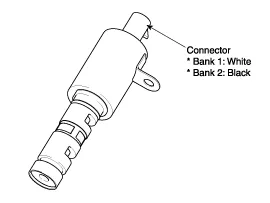Hyundai Genesis (DH): Engine Control System / CVVT Oil Control Valve (OCV) Description and Operation
| Description |

Inspection 1. Turn the ignition switch OFF. 2. Disconnect the PCSV connector. 3. Measure resistance between the PCSV terminals 1 and 2. 4.
Specification ItemSpecificationCoil Resistance (?)6.9 ~ 7.9 [20
Other information:
Hyundai Genesis (DH) 2013-2016 Service Manual: Power Mosfet Repair procedures
Inspection 1. Turn the ignition switch ON. 2. Manually operate the control switch and control the voltage of the blower motor. 3. Select the control switch to raise the voltage until high speed. Specification Fan Speed (Manual)Motor Voltage (V)13.
Hyundai Genesis (DH) 2013-2016 Service Manual: Intake Actuator Repair procedures
Inspection 1. Turn the ignition switch OFF. 2. Disconnect the intake actuator connector. 3. Verify that the intake actuator operates to the fresh position when connecting 12V to terminal 3 and grounding terminal 4. Verify that the intake actuator operates to the recirculation position when connected in reverse.
Categories
- Manuals Home
- Hyundai Genesis Owners Manual
- Hyundai Genesis Service Manual
- Engine Control / Fuel System
- Emission Control System
- Heating, Ventilation and Air Conditioning
- New on site
- Most important about car
